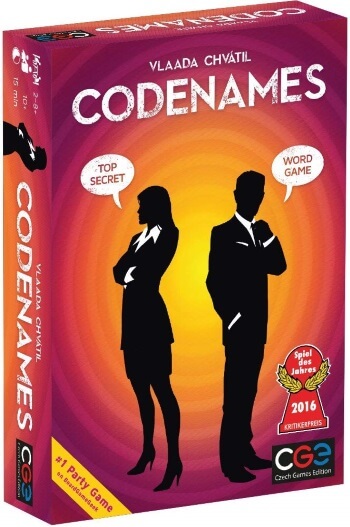This is the page for the official Codenames game rules for those looking for instructions on how to play Codenames as advised by the game designer and publisher.
Codenames at a Glance
| Game Type Team Based, Word, Deduction, Memory, Push Your Luck | Play Time 15 mins (approx) | Skill/Complexity (1.5 - 5) Light |
| Age 14+ | Publisher(s) Czech Games | Published 2015 |
| Categories Family Party / Word | Players 2 - 8 + (best 6 - 8) | Rules Manual Official Rules |
| Our Rating 9/10 | Cost $19.99 approx | Related Codenames Duet Games Like Codenames |
Components
- 16 agent cards in two colors
- 1 double agent card
- 7 innocent bystander cards
- 1 assassin card
- 40 key cards
- 1 rulebook
- 1 card stand
- 1 sand timer
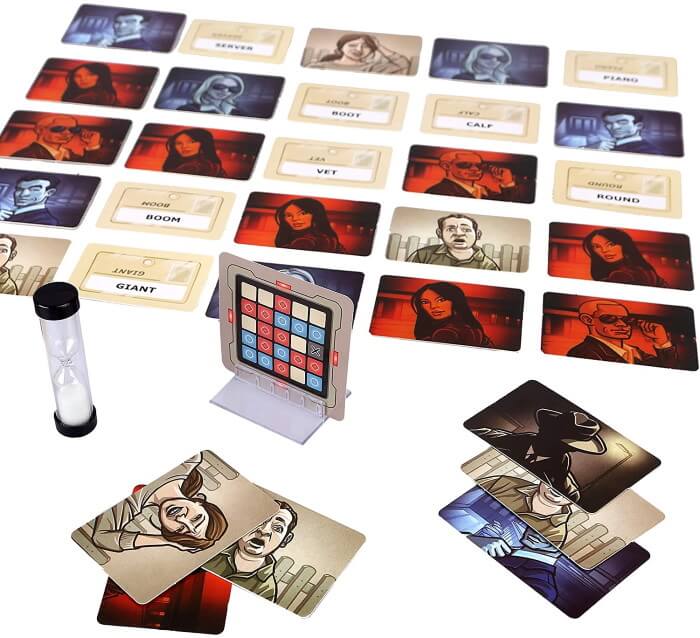
Setup
Players split up into two teams of similar size and skill. You need at least four players (two teams of two) for astandard game. Variants for two or three players can be found on the back page.
Each team chooses one player to be their spymaster. Both spymasters sit on the same side of the table. The other players sit across from their spymasters. They are field operatives.
Randomly choose 25 codenames and place them on the table in a 5-by-5 grid.
Note: While shuffling the codename cards, be sure to flip over half the deck once in awhile. This will mix the words more thoroughly.
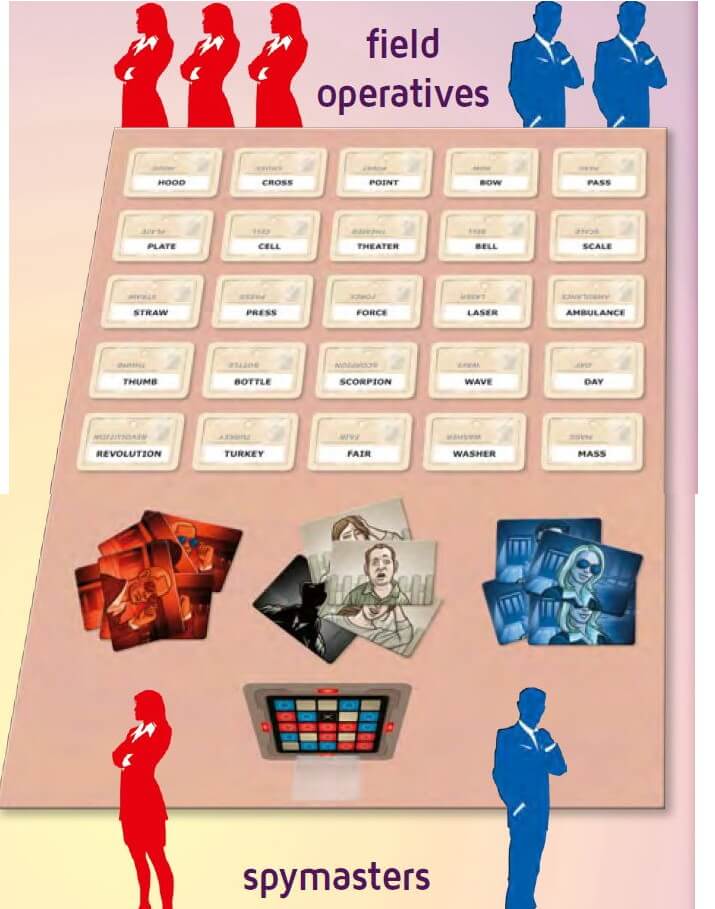
The Key
Each game has one key that reveals the secret identities of the cards on the table. The spymasters should choose the key card randomly and slide it into the stand between them. Any side can be up. Don’t think about it. Just slide it into the stand. And don’t let the field operatives see it.
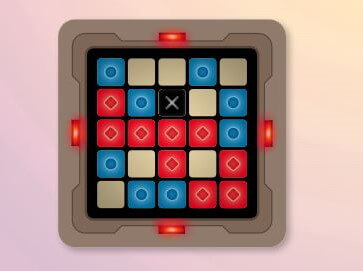
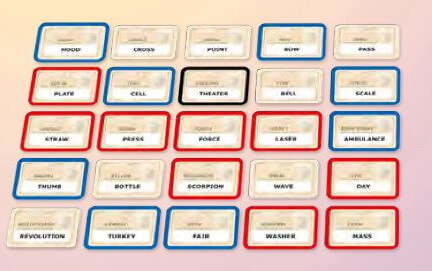
The key corresponds to the grid on the table. Blue squares correspond to words that Blue Team must guess (blue agents). Red squares correspond to words that Red Team must guess (red agents). Pale squares are innocent bystanders, and the black square is an assassin who should never be contacted at all!
Starting Team
The four lights around the edge of the key card indicate which team starts. The starting team has 9words to guess. The other team has8. The starting team will give the first clue of the game.
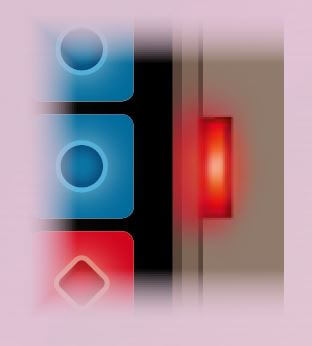
Agent Cards
The 8 Red Agent Cards go in a stack in front of the red spymaster. The 8 Blue Agent Cards should be in front of the blue spymaster. This helps everyone remember which team they are on.
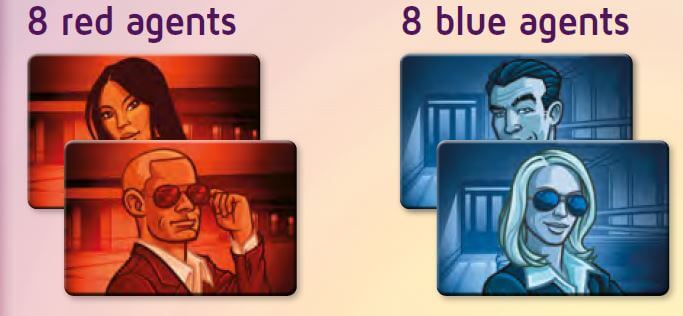
The 1 Double Agent belongs to whichever team starts. Flip it to that team’s color. It will be one of that team’s agent cards for the duration of the game

The 7 Innocent Bystander Cards and the 1 Assassin should be kept in between, where both spymasters can reach them easily.
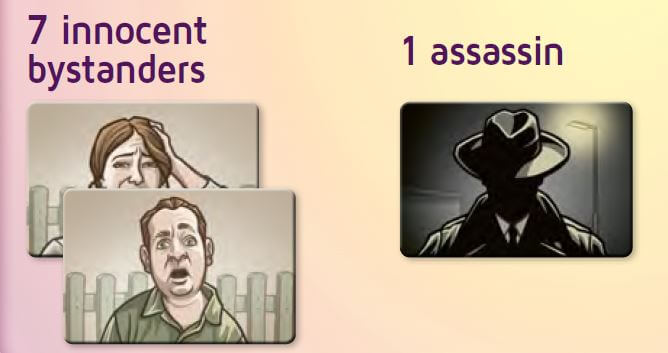
Game Overview
Spymasters know the secret identities of 25 agents. Their teammates know the agents only by their codenames.
Spymasters take turns giving one-word clues. A clue may relate to multiple words on the table. The field operatives try to guess which words their spymaster meant. When afield operative touches a word, the spymaster reveals its secret identity. If the field operatives guess correctly, they may continue guessing, until they run out of ideas for the given clue or until they hit a wrong person. Then it is the other team’s turn to give a clue and guess. The first team to contact all their agents wins the game.
Game Play
Teams take turns. The starting team is indicated by the 4 lights on the edges of the key card.
Giving a Clue
If you are the spymaster, you are trying to think of a one-word clue that relates to some of the words your team is trying to guess. When you think you have a good clue, you say it. You also say one number, which tells your teammates how many codenames are related to your clue.
Example: Two of your words are NUT and BARK. Both of these grow on trees, so you say tree: 2.
You are allowed to give a clue for only one word (cashew: 1) but it’s fun to try for two or more. Getting four words with one clue is a big accomplishment.
One Word
Your clue must be only one word. You are not allowed to give extra hints. For example, don’t say,”This may be a bit of a stretch…” You are playing Codenames. It’s always a bit of a stretch.
Your clue cannot be any of the codenames visible on the table. On later turns, some codenames will be covered up, so a clue that is not legal now might be legal later.
Making Contact
When the spymaster gives a clue, his or her field operatives try to figure out what it means. They can debate it amongst themselves, but the spymaster must keep a straight face. The operatives indicate their official guess when one of them touches one of the codenames on the table.
• If the field operative touches a card belonging to his or her team, the spymaster covers the word with an agent card in that color. The operatives get another guess (but not another clue).
• If the field operative touches an innocent bystander, the spymaster covers it with an innocent bystander card. This ends the turn.
• If the field operative touches a card belonging to the other team, the word is covered by one of the other team’s agent cards. This ends the turn. (And it helps the other team.)
• If the field operative touches the assassin, the word is covered by the assassin card. This ends the game! The team that contacted the assassin loses.
Tip: Before saying your clue out loud, make sure it doesn’t relate to the assassin.
Number of Guesses
The field operatives must always make at least one guess. Any wrong guess ends the turn immediately, but if the field operatives guess a word of their team’s color, they can keep guessing.
You can stop guessing at any time, but usually you want to guess as many words as the spymaster said. Sometimes you might even want to guess one more:
Example: Red Team's first clue was tree: 2. The red operative wanted to guess ORANGE and NUT. She guessed ORANGE first. That was an innocent bystander, so she did not get a chance to guess NUT. Blue Team took a turn and correctly guessed two words. Now it is Red Team's turn again. The red spymaster says river: 3. The red operative is pretty sure the AMAZON is a river, so she touches that card. The spymaster covers it with a red agent card, so she gets to go again. A river has a BED, so she touches that codename. It's also red, so she can go again. She's not sure of the third river word. She picks NUT. This has nothing to do with river. She is guessing a word from the previous clue. NUT is a red word. The operative has made 3 correct guesses for the clue river: 3. She is allowed one final guess. She can try to find the third river word, or she can try to find the other tree word. Or she can stop at three and let Blue Team have a turn.
You are allowed only one extra guess. In the example above, the red operative would be allowed 4guesses because her spymaster said the number 3. When the field operatives say they are done guessing (or when they guess wrong) it is the other team’s turn.
Penalty For Invalid Clues
If a spymaster gives an invalid clue, the team’s turn ends immediately. As an additional penalty, the other team’s spymaster may cover one of his or her words with an agent card before giving the next clue. But if no one notices that a clue is invalid, it counts as valid.
Keeping A Straight Face
The spymaster is expected to keep a straight face. Do not reach for any card while your teammates are considering the words. When a teammate touches a word, consult the key card and cover the word with the card of the corresponding color. When a teammate chooses a word of the correct color, you should act as though it was exactly the word you meant, even if it wasn’t.
If you are a field operative, you should focus on the table when you are making your guesses. Do not make eye contact with the spymaster while you are guessing. This will help you avoid nonverbal cues.
When your information is strictly limited to what can be conveyed with one word and one number, you are playing in the spirit of the game.
What’s The Timer For?
Sorry. We almost forgot. You see, we don’t use the sand timer very often.
If a player is thinking too long, any player can flip the sand timer and ask the slow player to make a decision before time runs out.
If you are having trouble, you can even use the sand timer on yourself. If you can’t find a good clue before time runs out, just give a clue for your hardest word and keep thinking while the other team plays.
If you prefer to play with strict time limits, you can download the timer app at codenamesgame.com.
Valid Clues
We playtested various rules. Some groups like the rules one way. Some like the rules another way. You should experiment to find out what your group likes.
Firm Rules
Some clues are invalid because they violate the spirit of the game.
Your clue must be about the meaning of the words. You can’t use your clue to talk about the letters in a word or its position on the table. Gland is not a valid clue for ENGLAND. You can’t tie BUG, BED, and BOW together with a clue like b: 3 nor with a clue like three: 3. However…
Letters and numbers are valid clues, as long as they refer to meanings. You can use X: 1as a clue for RAY. You can use eight: 3 as a clue for BALL, FIGURE, and OCTOPUS.
The number you say after your clue can’t be used as a clue. Citrus: 8 is not a valid clue for LEMON and OCTOPUS.
You must play in English. A foreign word is allowed only if the players in your group would use it in an English sentence. For example, you can’t use Apfel as a clue for APPLE and BERLIN, but you can use strudel.
You can’t say any form of a visible word on the table. Until BREAK is covered up by a card, you can’t say break, broken, breakage, or breakdown.
You can’t say part of a compound word on the table. Until HORSESHOE is covered up, you can’t say horse, shoe, unhorsed, or snowshoe
Homonyms & Spelling
English has many homonyms and homo-phones. E. g. night sounds like knight, but these two words don’t mean the same thing.
Same-sounding words with different meanings and different spellings are considered different words. So you can’t give knight-related clues for NIGHT.
Words that are spelled the same are considered the same even though they might have different pronunciations and meanings. For example, actors take a bow and the bow is part of a ship, so you could use bow as a clue for THEATER and SHIP. You could also use it as a clue for archery-related things, even though that bow is pronounced differently.
You are allowed to spell out your clue. For example, if you want your teammates to guess THEATER and STRING, you can spell out b-o-w without committing to a pronunciation. You can give the clue k-n-i-g-h-t even when NIGHT is one of the codenames on the table. (But you can’t use t-h-e-a-t-r-e when THEATRE is on the table. Theater and theater are different forms of the same word.)
You should spell out your clue if someone asks. If you aren’t that strong on spelling, ask the opposing spymaster for help.
Tip: Spelling is not just for homonyms. It’s also useful when the room is noisy or when the players have very different accents.
Don’t Be Too Strict
England and island were originally compound words, but in this century, island is a valid clue for ENGLAND. Even land is a valid clue for ENGLAND. And anybody who says you can’t say sparrow when ROW is on the table is just trying to cause trouble.
If the opposing spymaster allows it, the clue is valid. If you aren’t sure, ask your opponent. (Quietly, so the others can’t hear.)
Flexible Rules
Sometimes you have to make judgment calls about what is valid and what is not. Different groups may prefer to play the game differently. Compound Words English has three ways to write a compound word. Greenhouse is one word. Pack rat is two words. Mother-in-law is hyphenated. Technically, only greenhouse can be a one-word clue. You can decide to allow any compound words. However, in no case should a player be allowed to invent compound words. Lunar squid is not a valid clue for MOON and OCTOPUS. Proper Names Proper names are always valid clues if they follow the other rules. George is a valid clue, but you might want to specify whether you mean George Washington or George W. Bush. Your group can agree to count proper names as one word. This would also allow titles such as The Three Musketeers. Even if you don't allow multi-word proper names, you might want to make an exception for place names like New York. Spymasters should not be allowed to make up names, not even names that turn out to be real. Sue Mee is not a valid clue for CHINA and LAWYER Acronyms and Abbreviations Technically, CIA is not one word. But it is a great clue. You can decide to allow common abbreviations like UK, lol, and PhD. And words like laser, radar, and sonar are always allowed, even though they originated as acronyms. Homonyms Some people prefer to allow a more liberal use of homonyms. You can allow knight to be a clue for night-related things if that makes the game more fun for you. Rhymes Rhymes are always valid when they refer to meanings. Snail is a valid clue for MAIL because this rhyme is a common phrase. Snail is also a valid clue for WHALE because they are both animals. Snail is not a valid clue for SCALE because their main association is through the sound of the words. (If someone in your group has a job weighing snails, however, this clue is perfectly fine.) Some people like to allow any kind of rhyming clue. If you decide to allow this, just remember that you aren't allowed to indicate you are giving a rhyming clue. Your operatives will have to figure that out for themselves.
Expert Clue: Zero
You are allowed to use 0 as the number part of your clue. For example, feathers: 0 means, “None of our words relate to feathers.
If 0 is the number, the usual limit on guesses does not apply. Field operatives can guess as many words as they want. They still must guess at least one word.
If you’re not sure why this is useful, don’t worry. You’ll figure it out.
Expert Clue: Unlimited
Sometimes you may have multiple unguessed words related to clues from the previous rounds. If you want your team to guess more than one of them, you may say unlimited instead of a number. For example feathers: unlimited.
The disadvantage is that the field operatives do not know how many words are related to the new clue. The advantage is that they may guess as many words as they want.
Game Flow
Spymasters take turns giving clues. After a spymaster gives a clue, his or her team starts guessing. Their turn ends when they guess wrong, when they decide to stop, or when they have made the maximum number of guesses for that clue. Then it is the other team’s turn.
Ending The Game
The game ends when one team has all their words covered. That team wins.
It’s possible to win on the other team’s turn if they guess your last word.
The game can end early if afield operative makes contact with the assassin. That operative’s team loses.
Setup for the Next Game
Do other people want a chance to be spymasters? Setup for the second game is easy. Remove the cards covering the codenames and put them back in their stacks. Now just flip over the 25 codenames, and you’re ready to go!
With Fewer Players
Two Player Game
If there are only two of you, you can play on the same team. This two-player variant also works for larger groups of people who don’t feel like competing against each other. You will try to get a high score against a simulated opponent.
Set up the game as usual. One player will be the spymaster and the rest will be field operatives. The other team has no players, but you still need their stack of agent cards.
Your team should go first, so be sure to pick a key card that makes you the starting team.
Play your turns as usual. Try to avoid enemy agents and the assassin.
The spymaster simulates the enemy team by covering up 1of their words each time they get a turn. The spymaster gets to choose which word is covered, so there is a bit of strategy here.
If your team contacts the assassin, or if all the enemy agents are contacted, you lose. There is no score.
If your team wins, give yourselves a score based on how many agent cards are still left in the enemy’s stack.
Note: Your score will be determined by how many turns you needed and also by how many enemy agents you contacted accidentally.
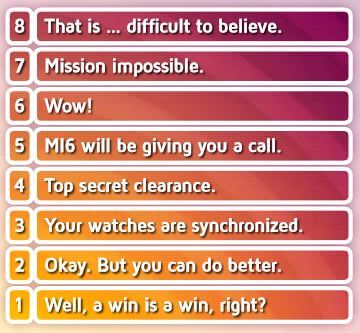
Three Player Game
Three players who want to be on the same team can play as described above. If two players want to compete against each other, they can be spymasters and the third player can be their operative.
Setup and game play are as usual, except that the single field operative is working for both sides.(Just like spies in real life!) The winning spymaster is determined in the usual way. The field operative tries to do a good job for both sides.
That’s all for the Codenames card game rules section on how to play. Check out our review of the game HERE!
If you have come to love Codenames then you may like some of these games we added in the Games Like Codenames roundup.
During 2017 Czech Games had the cooperative version of this game published ‘Codenames Duet’ that you wish to check out.
